Basic Steps 2:
Wax Lines


The Basic Steps: How to Write a Pysanka
Handling the egg:
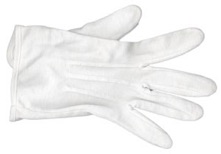
The gloves are inexpensive, washable and easily available. I will wear them when my hands become stained with pysanka dyes; although bleach will easily remove the dyes from my hands, it dries my skin horribly. Soap and water will remove most dye from my hands after a few washings. ( I normally wear only one glove, on my left hand, as that is the hand I hold my egg with.)
(2) Eggs are fairly delicate, and can break quite easily. This is particularly frustrating if the egg breaks after a lot of work has been put into it. To avoid dropping and breaking the egg, rest it on your work area while working with it. Do not hold it in mid-air – it is a recipe for disaster (or scrambled eggs)!
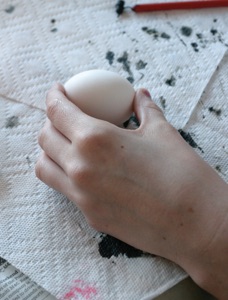

Yes! Egg stabilized on work surface No! Egg held up in the air
Apply the design in wax:
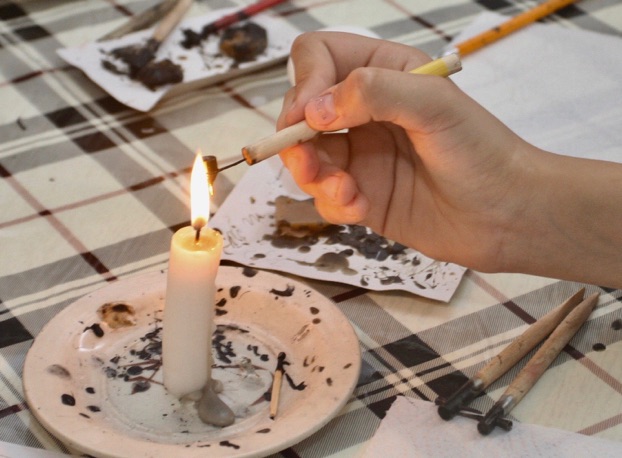
Heat the entire head of a Delrin-style stylus prior to scooping wax
If you are using a traditional stylus with a metal cone set into a wooden handle, heat only the opening of the funnel, or the handle may catch on fire.

Traditional wooden-handled stylus

Modern plastic-handled Delrin stylus
-
(2)Scoop a small amount of beeswax into the opening of the reservoir (or into the funnel of the stylus).
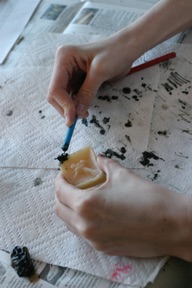
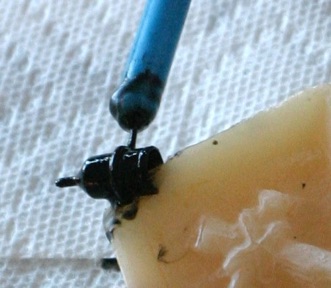
If the stylus does not scoop up the wax easily (like cutting through butter), the stylus may not be hot enough. Heat it a bit longer and try again, rather than trying to force it.
(3) Reheat the stylus, placing the tip into the flame until the wax is melted. (If using a wooden stylus, heat only the writing tip to avoid conflagration.) If you leave the stylus in the flame too long, the wax will get too warm and “blob” when you try to write. Counting slowly to three will usually give you enough reheating time.

Heating the tip prior to writing – the flame is hottest where it is bluest
(4) Test the wax flow from the stylus on some paper or your fingernail before writing any wax lines on the egg. Occasionally, from over-filling or over-heating, the stylus will let out a large blob of wax. If this should happen on the egg, there is nothing you can do. The wax bonds instantly to the eggshell; even if you try to scrape the wax off, the blob will still appear in your final design.
Don't feel badly if this happens –– even the most experienced egg artists have the occasional blobs in their designs. If at all possible, try to incorporate it into the design. If you can't, remember: any art made by humans is going to have mistakes in it –– that's what makes each egg truly unique. (And also remember that there are two sides to an egg, and you get to decide which side to display!)
(5) Apply wax to the egg. Study your pattern. Everywhere that there are white lines in the pattern, apply the wax. Remember that the pencil lines are just meant to be guides, and that you won't be covering all of them with wax. Hold he stylus in a manner that is comfortable for you. I prefer to hold it as shown in the photo below; you may find some other way works better for you.
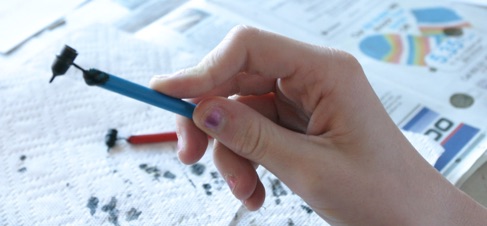
One proper way to hold a stylus
Write your design on both sides of the egg. Use a fine stylus for fine, delicate lines, a heavy stylus for filling in large sections of color and for dots, and a medium stylus for everything else.

Using a medium stylus to write on a pysanka
Repeat this process with each subsequent dye color. Once you’ve reached your final color, quit applying wax.

Remember: The dyes will not penetrate under the wax (unless, of course, you forget an egg in the dye, and leave it in there for several hours). Once an area is sealed, it will remain that color. You don't need to re-apply wax every time you dip an egg into a dye; just apply the new lines for that color.

You can download a previous .pdf version of parts 1 and 2 here. Please feel free to print it out and share it (e.g. classes). If you wish to reproduce this content in a publication, or on another web site, please ask.
Web page updated 2-21-2019
Note: All photos, illustrations and text © Luba Petrusha 2007. All Rights Reserved. Reproduction prohibited without expressed consent. May contact via e-mail (link below).
Back to Main Basics page
Back to Main Pysankarstvo page.
Back to MAIN Pysanka home page.
Search my site with Google



